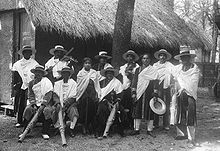Valiha
Valiha is a tubular bamboo zither on the island of Madagascar . The valiha is considered the national instrument of the country and is played mainly for entertainment and also in rituals that are held for obsessive spirits ( tromba ).
Design and style of play
In older types of valiha-volo torotenany , the pitches are given by small sticks that are wedged between the reed and the strings . The strings are made of the bamboo tube itself, so they are idiochord. The upper layer of the bamboo cane between two growth nodes is cut into longitudinal strips with a knife, the ends of which remain on the cane and are wrapped with bast or leather straps. The strings are tensioned by sliding wooden blocks. Their number varies depending on the diameter and spacing of the bamboo rings and can be more than 18. An instrument can be over a meter long.
In the newer constructions called valiha-volo or valiha jihy vihy , metal strings run along the bamboo tube over sliding bridges. Instruments with strings made from a different material are called heterochord. The valiha is decorated with folk motifs and is usually played with the fingernails .
Three instruments are distinguished from the tuning: a pentatonic , a diatonic ( valiha lalabdava ) and a chromatic valiha. In Madagascar, the valiha is played at both family celebrations and religious ceremonies. The instrument is held either between the legs or under the arm and plucked with both hands.
The valiha can accompany all other instruments, but it can also be played solo. It is used in traditional folk music, but also in modern Malagasy music.
distribution
The origins of the bamboo tube zithers lie in the Southeast Asian countries Indonesia , Malaysia , the Philippines and Vietnam . The sasando , the old national instrument of the Indonesian island of Roti, is of particular importance in terms of music history . It is a heterochorde bamboo zither with 10 to 36 or more metal strings. Idiochorde tubular bamboo zithers, which are struck with sticks and used as a percussion instrument, are the chigring of the Garo in northeast India and the gintang in the local state of Assam .
Full-tube zithers do not occur on the African mainland. The rare half- tubular zithers in southern Africa include the now obsolete tshidzholo , whose string support often consists of a section of bamboo cut in half, and the segankuru . Their groove, cut out of a wooden stick, represents the transition to the shell zithers, which are particularly common in East Africa.
From the relatively quiet bamboo zither a larger and louder box zither with a rectangular or round body was developed in Madagascar, which is commonly called marovany or valiha and around Morondava salegy . Zithers with a round body are strung with strings on one half and rectangular box zithers on the broad sides so that they can be plucked with both hands. A similar rectangular box zither in the Comoros is called ndzedze ( Swahili , related to zeze ).
Discography
- Valiha. Sounding bamboo. Madagascar 3rd CD on Fire and Ice, FUEC 712, 1992
literature
- August Schmidhofer: Valiha. In: Ludwig Finscher (Hrsg.): The music in past and present . Sachteil, Vol. 9, Bärenreiter-Verlag, Kassel 1998, Sp. 1230-1235.
- Rashid Epstein Adams: The Making of a National Instrument: Imagery, Symbolism and the Social Function of the Malagasy Valiha. In: Music in Art: International Journal for Music Iconography, Volume 43, No. 1–2, 2018, pp. 141–157, ISSN 1522-7464
Web links
Individual evidence
- ^ August Schmidhofer: On the individuality of musical design in Madagascar using the example of the zither virtuoso Mahia Andryasi. In: Musicologica Austriaca, Vol. 17, 1998, pp. 109-116


